Polyamide and Nylon are two common but often confused terms. Although they are frequently considered the same material in manufacturing processes, they actually differ.
Polyamide is a general term for thermoplastic resins containing repeating amide groups—[NHCO]—in the molecular backbone, including aliphatic PA, aliphatic-aromatic PA, and aromatic PA.
Nylon belongs to the aliphatic polyamide subcategory and was the first synthetic fiber to be developed in the world, while aromatic and semi-aromatic polyamides also fall under the broader category of polyamides.
In this article, we will delve into the comparation between polyamide vs nylon, distinguishing these two materials in terms of structure, properties, and applications.
What Is Polyamide?
Polyamide, commonly known as Nylon, is a high polymer whose repeating units in the molecular backbone contain amide groups.
Due to the strong polarity of the amide group, polyamide exhibits high crystallinity, a high melting point (180 – 260ºC), and excellent strength.
Polyamide is widely used in the production of fibers, plastics, and engineering materials due to its excellent mechanical strength, wear resistance, and chemical resistance.
Based on its molecular structure, polyamide can be categorized into the following types:
- Aliphatic Polyamide: Such as PA6 and PA66, which are typically used in the manufacture of fibers and plastics.
- Aliphatic-Aromatic Polyamide: A type of polyamide that combines the structural characteristics of both aliphatic and aromatic groups.
- Aromatic Polyamide: Such as Kevlar, known for its exceptional strength and heat resistance, commonly used in high-performance applications like bulletproof vests.

What Is Nylon?
Nylon is a specific material within the polyamide family, belonging to the subcategory of aliphatic polyamides.
The molecular structure of nylon consists of numerous repeating units linked by amide bonds, which are similar to the peptide bonds found in proteins.
As the world’s first synthetic fiber, nylon was developed by DuPont in the 1930s and was initially widely used in the manufacture of stockings, later expanding to other textiles and engineering materials.
The most common types of nylon include Nylon 6 and Nylon 66:
- Nylon 6: Produced through the ring-opening polymerization of caprolactam monomers.
- Nylon 66: Made through the polycondensation of adipic acid and hexamethylenediamine.
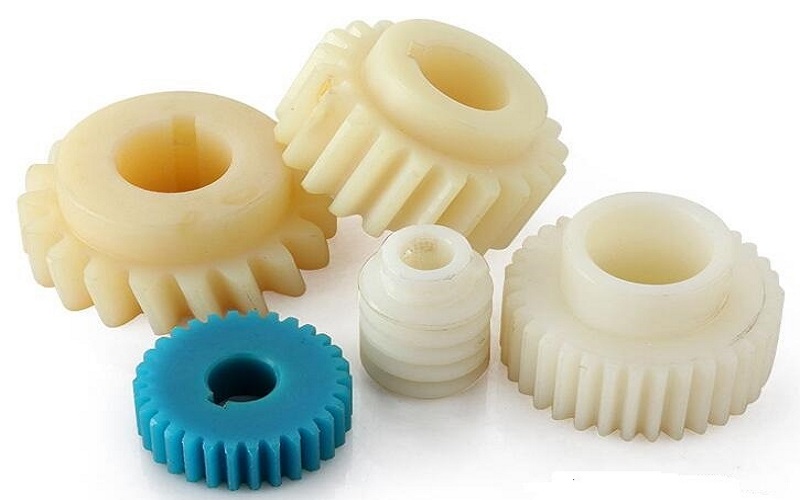
Polyamide vs Nylon:Structure
Polyamide and nylon share similar molecular structures, both being linear polymers composed of repeating amide groups.
However, differences in their chemical composition and polymerization methods lead to distinct properties.
Polyamide’s repeating units contain a -CONH- structure, making it stable and more prone to moisture absorption.
This gives polyamide fibers excellent softness, tensile strength, and wear resistance, making them ideal for fine threads, yarns, and textiles requiring durability and fatigue resistance.
On the other hand, the molecular structure of nylon consists of linear polymers formed by two amino groups paired with an acid group, with different types of nylon created from various repeating units.
This structure makes nylon harder and more durable, making it particularly suitable for manufacturing wear-resistant and durable materials such as outerwear, luggage, and buckets.
Main Properties Of Polyamides And Nylon
Polyamides and nylon have very similar properties, but there are also some differences, as shown below:
Melting Point
The melting point of polyamides and nylon is influenced by factors such as molecular chain length, intermolecular forces, and crystallinity.
For example, Nylon 6, with its shorter molecular chain, has a melting point of around 220ºC, while Nylon 66, with its longer molecular chain, has a slightly higher melting point of about 260ºC.
Moisture Absorption
Polyamides and nylon have relatively high moisture absorption because their primary components, aliphatic polyamides, contain amine and carbonyl groups.
These functional groups readily form hydrogen bonds with water molecules, causing the material to absorb moisture easily.
Chemical Stability
Polyamides and nylon exhibit good resistance to various chemicals, including oils, water, and certain solvents.
This makes them highly useful in many industrial applications.
Mechanical Strength
They exhibit excellent mechanical strength, especially in tensile strength and impact resistance, ideal for heavy and dynamic load applications like gears, bearings, and automotive parts.
Wear Resistance
Both materials are highly wear-resistant. Polyamide fibers are far more durable than cotton or wool, and nylon’s wear resistance can be enhanced by adding molybdenum disulfide, increasing its hardness and abrasion resistance.
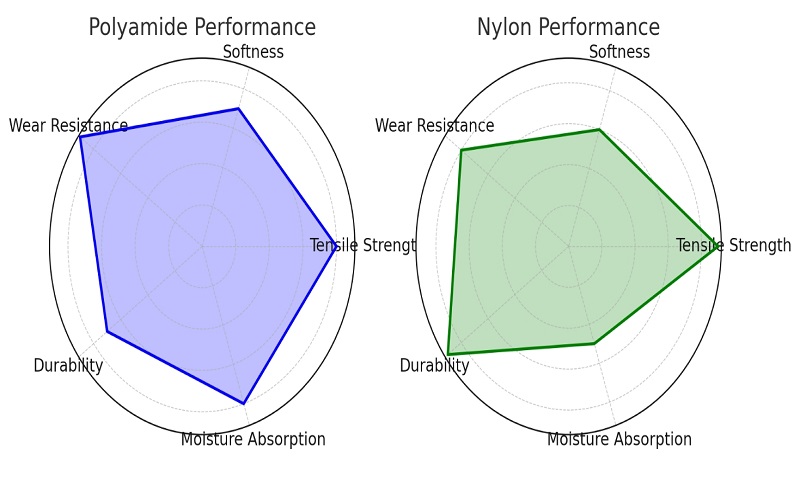
Manufacturing Techniques For Polyamide And Nylon
Polyamide and nylon are widely used polymers, with their primary processing methods being injection molding and 3D printing.
Nylon Injection Molding
Nylon injection molding is commonly used to manufacture parts that require high heat resistance and mechanical performance.
Its excellent flowability and high melting point result in molded parts with outstanding strength and durability.
Glass Filled Nylon Injection Molding
By adding glass fibers during the injection molding process, nylon’s strength, rigidity, and wear resistance are significantly enhanced.
Glass filled nylon injection molding parts are lightweight yet possess strength comparable to metal, making them ideal for high-load mechanical components and structural parts, especially in demanding industrial environments.
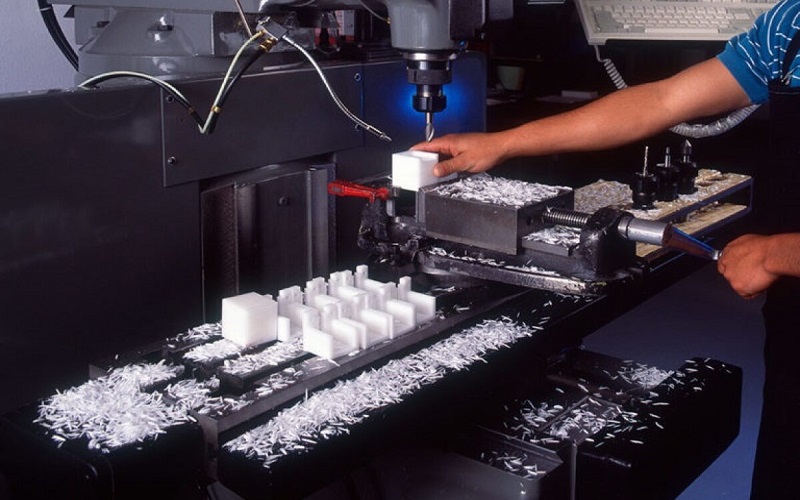
3D Printing
Polyamide performs exceptionally well in 3D printing, producing parts with high strength and toughness that are easy to post-process, such as sanding and painting.
Nylon is used in various 3D printing methods, with PA6 being common in FDM printing, while PA11 and PA12 are often used in powder-based processes.
Nylon 3D printed parts offer excellent strength, wear resistance, and fatigue resistance, making them suitable for functional prototypes and custom parts production.
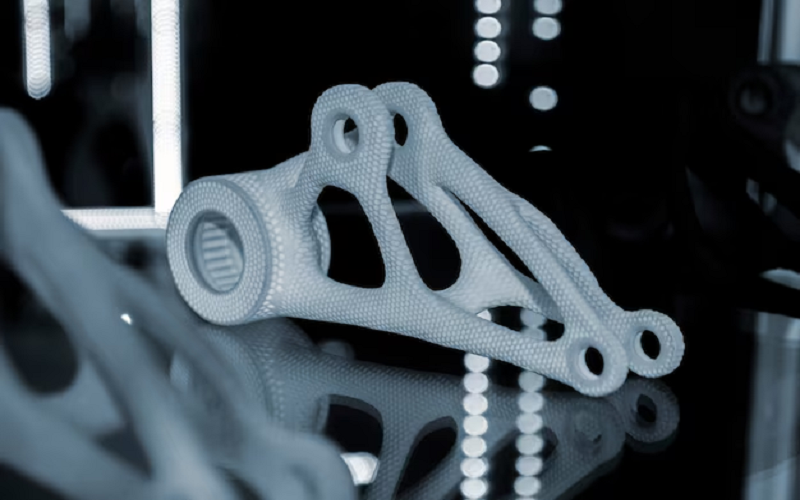
Whether plastic injection molding manufacturers or 3d printing companies are selecting polyamide and nylon materials, they should also choose the appropriate process based on production scale, part complexity, and surface quality requirements.
When To Use Polyamide And Nylon?
Polyamide has a smooth texture and high strength, coupled with excellent wear resistance and chemical resistance, making it ideal for manufacturing sports equipment, automotive interiors, machine components, medical devices, and high-temperature electrical parts.
Nylon is known for its superior mechanical strength and chemical stability, making it suitable for producing materials that require high strength and corrosion resistance.
It is commonly used in the production of ropes, synthetic materials, mechanical parts, chemical containers, automotive components, and electrical insulation parts.

Identifying The Safety Of Polyamide And Nylon
As a polymer widely used in everyday life, polyamide (nylon) plays an important role in various fields.
However, the question of “Is nylon safe?” often arises.
When used in appropriate amounts, polyamide is generally harmless to humans.
For example, it is used as a food packaging material that effectively prevents contamination and oxidation.
It is also widely used in medical devices, clothing, and automotive parts, with its safety and stability well-recognized.
Nonetheless, prolonged skin contact, especially with processed polyamide fiber products like clothing, may cause localized itching, redness, or skin allergies, varying from person to person.
Therefore, it is advisable to avoid prolonged use of polyamide-made clothing, especially for close-fitting garments.
Overall, polyamide (nylon) is safe under normal usage conditions, but in certain situations, it may have adverse effects on the body.
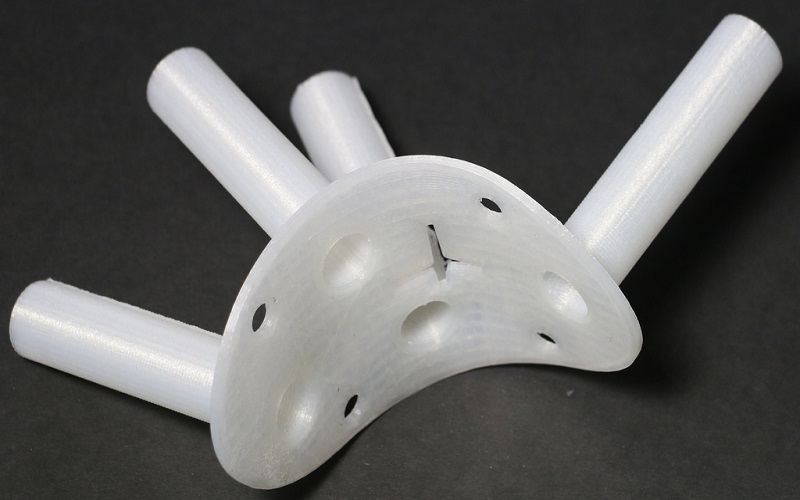
Is Polyamide Or Nylon Recyclable?
Although polyamide (nylon) is produced from non-renewable crude oil, innovative recycling technologies allow for the effective recycling of polyamide (nylon).
However, due to the lack of recycling facilities and proper channels in many areas, a large amount of nylon waste ends up in landfills or is incinerated, causing significant environmental harm.
Nylon recycling methods include physical and chemical recycling.
Physical recycling involves reprocessing and granulating waste nylon for further use, while chemical recycling converts it through a series of chemical processes into oil, gas, carbon, monomers, or even new plastic with qualities equivalent to petroleum-based plastics.
Overall, nylon is a material with sustainable potential. Although recycling faces challenges, enhancing recycling and reuse measures can reduce the negative impact of nylon’s lifecycle on the environment and resources.
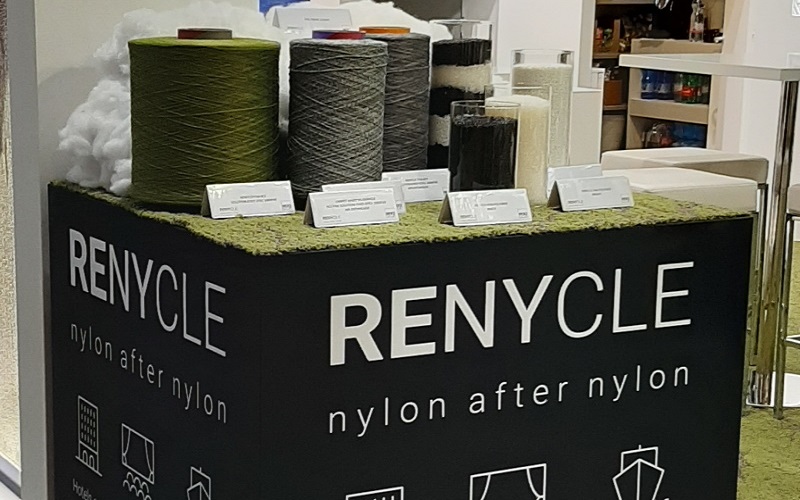
Differences Between Polyamide and Nylon
To more clearly compare the differences between polyamide and nylon, we present the results in a tabular format:
Points | Polyamide | Nylon
|
Define | A polymer made from repeating amide linkages (-CONH-). | A specific type of polyamide, widely known as nylon. |
Type | Includes various types such as aliphatic, semi-aromatic, and aromatic polyamides. | Typically refers to aliphatic polyamides |
Strength | High tensile strength | Excellent mechanical strength |
Durability | Highly durable, resistant to wear, fatigue, and chemicals. | Extremely durable, with superior wear resistance and stability in harsh environments. |
Absorbency | Tends to absorb moisture | Higher moisture absorption |
Safety | Generally safe for use in various applications, including medical devices. | Safe under normal use, but prolonged skin contact with some forms may cause irritation in sensitive individuals. |
Application | Used in textiles, industrial components, medical devices, automotive parts. | Commonly used in ropes, synthetic fabrics, automotive components, and industrial parts. |
Conclusion
Polyamide and nylon share a close parent-child relationship, with each excelling in its own way.
Polyamide encompasses a broad range of polymers, including nylon, one of its most widely used subsets.
This diversity enables polyamides to perform well in various applications, from textiles to industrial components.
Nylon, known for its mechanical strength and durability, is ideal for high-load and high-strength products.
Both materials share common traits while also standing out in their unique applications, complementing each other in practical use.
If you’re still unsure whether to choose polyamide or nylon for your project, FOWMOULD is here to provide you with the most reliable advice.
Contact us to get a free quote for polyamide (nylon) injection molding!
